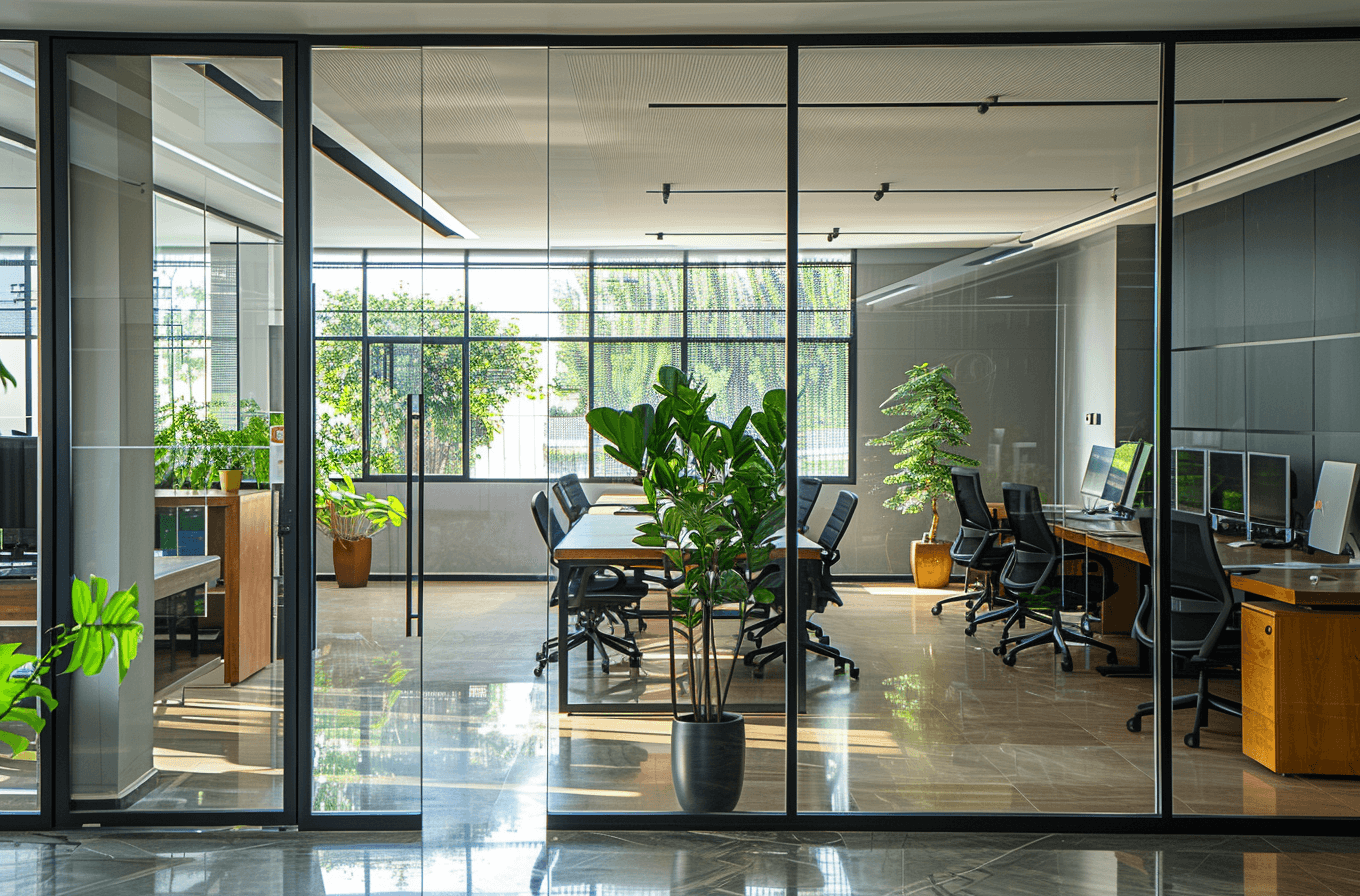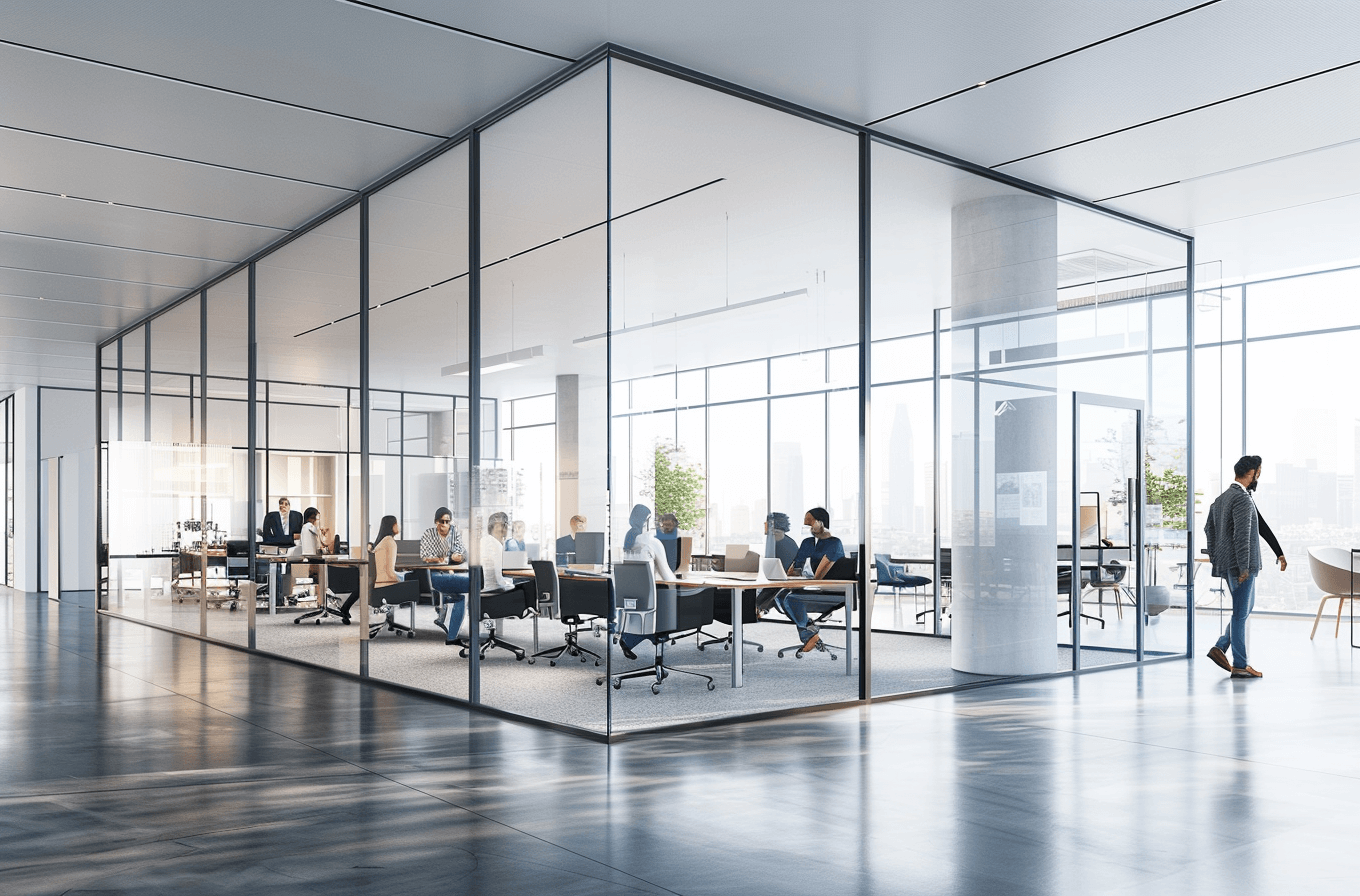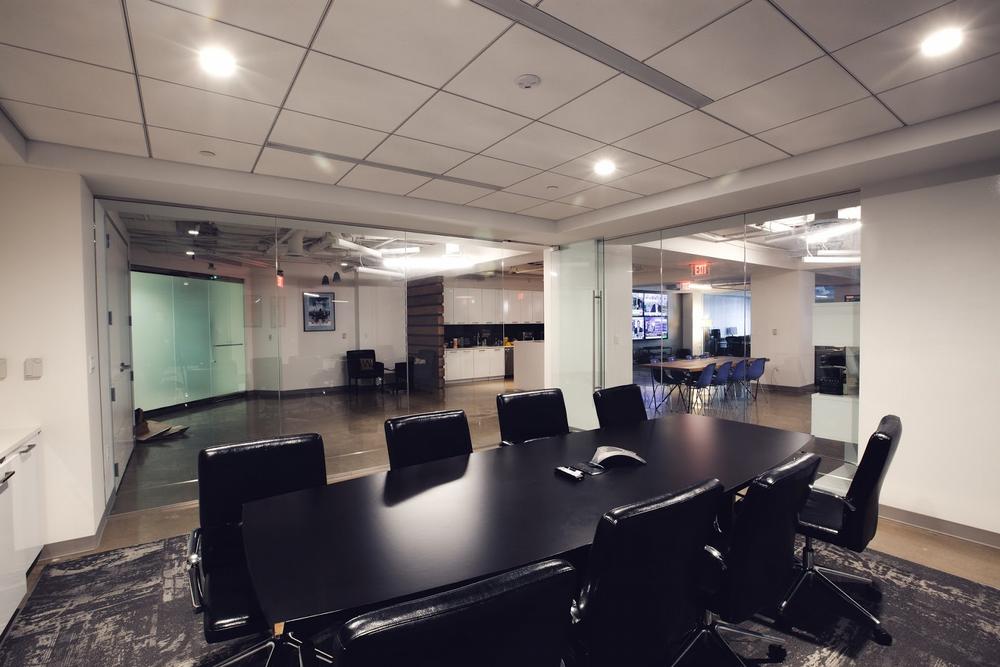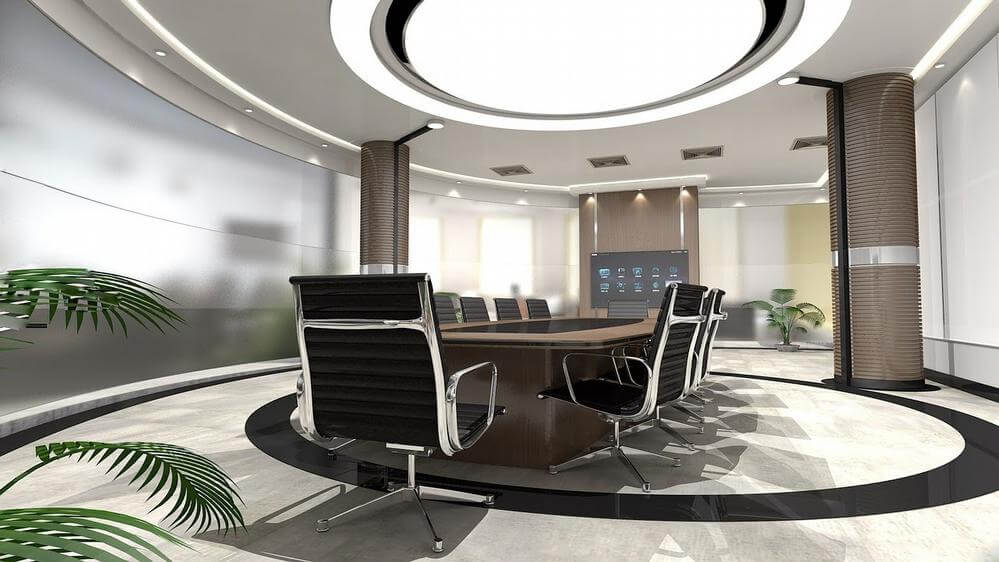As the world continues to grapple with the challenges of climate change and environmental degradation, businesses are increasingly recognizing the importance of sustainability. One of the key areas where companies can make a significant impact is in the design and management of their office spaces. Among the various sustainable design choices available, the use of glass partitions stands out for its numerous environmental benefits. Glass partitions not only contribute to a healthier and more sustainable workplace but also offer aesthetic and functional advantages that can enhance productivity and well-being.
In this comprehensive blog, we will explore the environmental benefits of using glass partitions in offices, examining how they contribute to energy efficiency, resource conservation, waste reduction, and indoor environmental quality. We will also discuss how the use of glass partitions aligns with broader sustainability goals and can support a company’s commitment to environmental responsibility.
1. Energy Efficiency and Natural Light
One of the most significant environmental benefits of using glass partitions in offices is their ability to enhance energy efficiency by maximizing the use of natural light. Traditional office layouts with solid walls often rely heavily on artificial lighting, which can consume a considerable amount of energy. In contrast, glass partitions allow natural light to flow freely throughout the workspace, reducing the need for artificial lighting during daylight hours.
Maximizing Natural Light: Natural light is a valuable resource that not only improves the aesthetic appeal of an office but also has numerous health and productivity benefits for employees. By using glass partitions, offices can maximize the amount of natural light that penetrates deep into the interior spaces. This reduces the reliance on artificial lighting, which is often energy-intensive and costly. Studies have shown that natural light can improve mood, increase alertness, and boost overall productivity, making it a win-win solution for both the environment and the workforce.
Reducing Energy Consumption: The reduction in energy consumption associated with artificial lighting is a direct environmental benefit of glass partitions. According to the U.S. Energy Information Administration, lighting accounts for approximately 17% of electricity use in commercial buildings. By allowing natural light to illuminate the workspace, businesses can significantly reduce their electricity consumption, leading to lower carbon emissions and reduced demand on the power grid. This is particularly important in regions where electricity is generated from fossil fuels, as reducing energy consumption directly translates to a lower carbon footprint.
Supporting Passive Heating and Cooling: Glass partitions can also play a role in enhancing the passive heating and cooling of office spaces. In cooler climates or during the winter months, glass partitions can help to distribute sunlight more evenly, warming the office naturally and reducing the need for heating. Conversely, in warmer climates, strategically placed glass partitions can help to minimize direct sunlight and prevent overheating, reducing the need for air conditioning. By optimizing the use of natural light and heat, glass partitions contribute to a more energy-efficient and comfortable indoor environment.
2. Resource Conservation and Sustainable Materials
Another key environmental benefit of glass partitions is their contribution to resource conservation through the use of sustainable materials. Glass is a highly sustainable material that can be recycled and reused multiple times without losing its quality or integrity. This makes glass an excellent choice for environmentally conscious businesses looking to minimize their resource consumption and reduce their environmental impact.
Recyclability and Reuse: One of the most significant advantages of glass as a building material is its recyclability. Unlike many other materials that degrade in quality after recycling, glass can be recycled indefinitely without losing its clarity or strength. This means that glass partitions can be produced from recycled glass, reducing the demand for raw materials and minimizing the environmental impact of glass production. Furthermore, at the end of their useful life, glass partitions can be recycled again, closing the loop and contributing to a circular economy.
Longevity and Durability: In addition to being recyclable, glass is also a durable and long-lasting material. Glass partitions are resistant to wear and tear, and with proper care and maintenance, they can last for decades. This longevity reduces the need for frequent replacements, conserving resources and reducing waste. The durability of glass also means that it can be repurposed or reused in different configurations, further extending its lifespan and minimizing its environmental impact.
Sustainable Manufacturing Processes: The environmental benefits of glass partitions are further enhanced by the sustainable manufacturing processes used in their production. Many glass manufacturers have adopted eco-friendly practices, such as using energy-efficient technologies, sourcing raw materials responsibly, and minimizing waste and emissions. By choosing glass partitions from manufacturers committed to sustainability, businesses can further reduce their environmental footprint and support the development of a greener economy.
3. Waste Reduction and Circular Economy
The use of glass partitions in offices also contributes to waste reduction, both in the construction and operation of office spaces. By opting for glass partitions, businesses can minimize the amount of waste generated during the building process and support the principles of a circular economy.
Minimizing Construction Waste: Traditional construction methods often generate significant amounts of waste, particularly when using materials such as drywall, wood, and metal. In contrast, glass partitions can be prefabricated to precise specifications, reducing the need for cutting and modifying materials on-site. This not only speeds up the installation process but also minimizes the amount of waste generated. Additionally, any offcuts or leftover glass from the installation process can be recycled, further reducing waste.
Supporting a Circular Economy: The concept of a circular economy is centered around reducing waste, reusing materials, and recycling products at the end of their life cycle. Glass partitions are well-suited to this model, as they can be easily disassembled, relocated, and reused in different office configurations. This flexibility allows businesses to adapt their office layouts without generating unnecessary waste or requiring new materials. When glass partitions reach the end of their useful life, they can be recycled and used to produce new glass products, closing the loop and supporting a circular economy.
Reducing Office Renovation Waste: Office renovations and reconfigurations are common in dynamic business environments, but they often result in significant waste as old materials are discarded and new ones are brought in. Glass partitions offer a more sustainable alternative by allowing businesses to reconfigure their office spaces without generating large amounts of waste. Because glass partitions are modular and can be easily moved or repurposed, businesses can update their office layouts with minimal environmental impact. This reduces the need for new materials and decreases the amount of waste sent to landfills.
4. Improving Indoor Environmental Quality
Indoor environmental quality (IEQ) is a critical factor in the health and well-being of office workers. Poor IEQ can lead to a range of health issues, including respiratory problems, headaches, and fatigue, which can, in turn, reduce productivity and increase absenteeism. Glass partitions can play a significant role in improving IEQ by enhancing natural light, reducing the need for artificial lighting, and minimizing the use of potentially harmful materials.
Enhancing Air Quality: Glass partitions are non-porous and do not emit volatile organic compounds (VOCs), which are harmful chemicals that can be released from building materials, furniture, and cleaning products. VOCs are known to contribute to poor indoor air quality and can cause a range of health problems, including headaches, nausea, and respiratory issues. By using glass partitions, businesses can reduce the presence of VOCs in the office, contributing to a healthier indoor environment.
Reducing the Need for Artificial Lighting: As mentioned earlier, glass partitions allow natural light to penetrate deep into the office, reducing the need for artificial lighting. This not only conserves energy but also reduces the heat generated by artificial lights, which can affect indoor air quality. Excessive heat from lighting can lead to increased use of air conditioning, which can circulate dust, allergens, and other pollutants throughout the office. By reducing the reliance on artificial lighting, glass partitions help to maintain a more comfortable and healthy indoor environment.
Promoting a Healthy Work Environment: The use of glass partitions can also contribute to a healthier work environment by promoting a sense of openness and reducing feelings of confinement. Studies have shown that exposure to natural light and views of the outdoors can reduce stress, improve mood, and enhance overall well-being. Glass partitions allow employees to benefit from these positive effects, even if they do not have direct access to windows. The improved indoor environment can lead to higher job satisfaction, reduced stress levels, and increased productivity.
5. Supporting Green Building Certifications
For businesses committed to sustainability, achieving green building certifications such as LEED (Leadership in Energy and Environmental Design) or BREEAM (Building Research Establishment Environmental Assessment Method) is an important goal. These certifications recognize buildings that meet high standards of environmental performance in areas such as energy efficiency, resource conservation, waste management, and indoor environmental quality. The use of glass partitions can support these certifications by contributing to a building’s overall sustainability profile.
Contributing to LEED Points: The LEED certification program awards points for various sustainable building practices, including energy efficiency, daylighting, and the use of sustainable materials. Glass partitions can contribute to these points in several ways. For example, the use of glass partitions to maximize natural light and reduce energy consumption can earn points in the “Energy and Atmosphere” and “Indoor Environmental Quality” categories. Additionally, using glass partitions made from recycled materials or produced by manufacturers with sustainable practices can contribute to points in the “Materials and Resources” category.
Supporting BREEAM Assessments: Similar to LEED, the BREEAM certification assesses buildings on their environmental performance, including energy efficiency, resource use, and indoor environmental quality. Glass partitions can play a role in achieving a high BREEAM rating by supporting the efficient use of natural light, reducing energy consumption, and contributing to a healthy indoor environment. BREEAM also recognizes the use of sustainable and recyclable materials, further enhancing the benefits of glass partitions in achieving certification.
Enhancing Building Value: Achieving green building certifications can enhance the value of a commercial property by demonstrating a commitment to sustainability and environmental responsibility. Certified buildings are often more attractive to tenants and investors, who may be willing to pay a premium.








